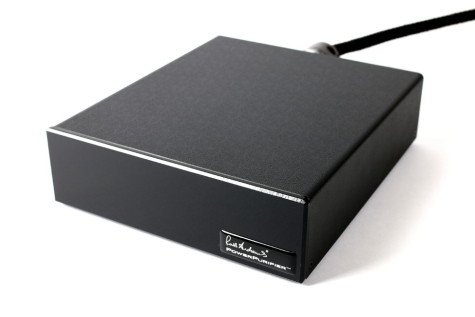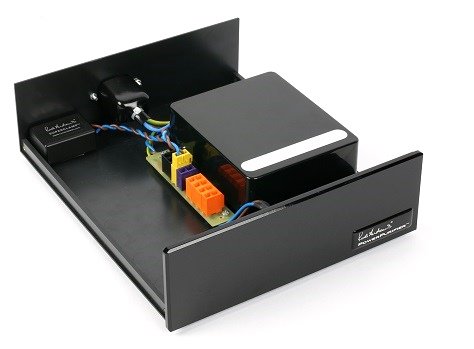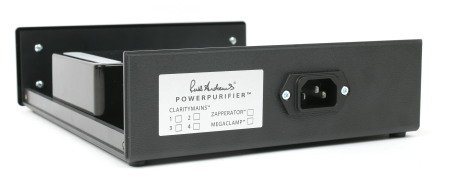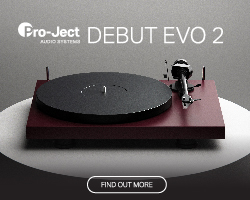The Russ Andrews Power Purifier is a modular power conditioner that you can have fully loaded from the off or choose the base unit and add to as and when you feel the need. Janine Elliot pops it on her rack and experiments with the £329 (base unit) £1107 (fully loaded) box.
Mains noise can sometimes be the biggest destroyer of sound quality in a system, and equally, some mains conditioners can do the same; altering EQ, reducing dynamic range, and narrowing soundstage. Where I might get excited about new hifi products, these are usually exotic turntables or honest sounding amplifiers of one form or another. Mains conditioners are likely to be last on my list, despite me having designed and regularly using them. The Russ Andrews Power Purifier is different to anything I have seen before and raised more than a few sparks of interest by me at a recent hifi show, so I requested to review the product.
This is not a “one size fits all” product, but rather it is one that you can tailor to your own finances and audio-visual needs and ‘add-to’ when necessary. This single box has space to accumulate different mains calming devices that you simply plug in yourself and stick down to the base of the unit with double-sided tape, that when joined together are there to combat the three major areas of mains contamination; spikes and surges, mains noise and Wi-Fi interference. All in a single 226mm x 68mm x 243mm plastic box with a high-gloss acrylic face panel with central blue indicator just so you know it is doing its job. Costing £329 it comes as standard with the Russ Andrews UltraPurifier™ filter and SuperClamp™ surge protection. You can tailor your PowerPurifier by adding extra filtering as and when your budget and needs allows, meaning a MegaClamp, a mains Zapperator and up to four ClarityMains can be fitted to the PowerPurifier. The review sample came complete with all options carefully attached. Russ Andrews will even connect all the additional filters you buy for free, just charging for the postage, though the Allen key supplied allows you to easily and quickly open the box to do all the work yourself, should you so wish.
Having recently celebrated their 30th anniversary, Russ Andrews is a name most hifi audiophiles will be aware of, from a humble small cabin in 1986 to their present empire and major presence at hifi shows. As well as a growing range of accessories to cater for most audio needs, they have particularly specialised in mains improvement products, all with great names and equally great claims.
Each element you attach has different uses. The PowerPurifier itself comes complete with two components; their UltraPurifier™, a basic broadband power conditioner, and their SuperClamp™. This part provides very rapid reaction to over-voltage spikes on the mains. RA recommends you replace this every five years to maintain its effectiveness. From the basic set up you can also add the following components;
The MegaClamp (at £180) which offers enhanced spike and surge protection, which is many times more effective than the SuperClamp. This unit will also last indefinitely.
The Mains Zapperator is a mains conditioner that deals with very high frequency noise that is particularly caused by wireless computer networks. At £142 extra this can be added to your Purifier.
The Clarity Mains is a mains conditioner that utilises “Coherence Technology”, and up to four of these boxes can be added to the PowerPurifier, with each one costing you a further £114. The “Coherence Technology” was introduced by Russ after he was approached back in 2007 by a US designer who had an audio device that claimed to help to reduce noise in signals. The Clarity Mains helps to reduce noise of the mains supply.
Whichever boxes you decide to add to your Purifier, each one comes with its own coloured connector, and which can only fit into its respective coloured socket, meaning that assembly is easy. Just remember that when you stick the boxes using the double-sided tape, you cannot re-position them later!
Their UltraPurifier™ filter also appears in the RA catalogue as a separate unit or built into products such as their 8-way Power blocks, largely due to its clever ‘shunt’ filter design, meaning that there are no components between the supply and the hifi or video equipment. It can simply be added where you want it to work. As a result I have found these designs have a much more mannered result than many a “conventional” mains conditioner that can change the audio frequency response or dynamic range, resulting in them sounding far different – even if at times that might make the sound more ‘exciting’ and therefore temporally more desirable. What actually set this unit more desirable for me was that the dynamic range didn’t shrink, moreover that it expanded, and using with video made colours clearer but not unreal as they can when you press the “dynamic” option on your TV or projector.
When I first saw their £301 mains plug with MiniPurifier and MegaClamp, and felt that while it might work well, its small size and plastic body wouldn’t inspire me to part with that sort of money. So whilst this unit under review now might be over 3 times size its basic setup only £18 more, this is amazing value and still a reasonable £1107 when fully charged with all the extras. Its design is more advanced and for me much more tempting, particularly as you can configure your own specification. Since it was not built into a 4 or 6 way mains extension lead it meant that testing the unit was far easier for me, as I could plug it in or not to hear the differences, without switching on and off all my hifi. Being based on the use of shunt-connected mains filters, it meant the devices could effectively ‘suck’ the interference out of the mains without actually coming between mains and audio equipment, thus less likely to turn into a glorified tone control.
For the review I had all the ingredients at my disposal, including 4 Clarity Mains blocks, and I tried different recipes to see how effective each part was, making a meal of assessing whether there were differences. I used my Slee power amplifiers with Townshend Rock 7 turntable and the Prism Audo Callia DAC as one of my systems, and Pre Audio turntable into Manley phonostage and modified vintage Leak Stereo20 power amplifier as the other.
Testing
I wasn’t able to create any audible spikes when testing; even after playing about with my fridge and other ‘noise’ creating artefacts. After many years of trying to create the perfect audio listening space that part of my mains is thankfully house-trained. However, my mains isn’t the cleanest, though thankfully modern power engines built into hifi separates can improve things, as does my own mains conditioner. Removing my own conditioner to try another product was like weaning my children off their favourite food to try another brand. Initially I needed to remove all conditioning completely to get used to that sound and then try the RA. Playing music I knew well, including recordings I had made or been in the studio when they were produced helped me to know what I should be listening for.
The PowerPurifier works passively, meaning that it doesn’t have the drawbacks of some other mains filters – things like loss of musicality and reduced dynamic range. The latter degradation is something I have noticed with many conditioners I have tested over the years. In some respects this type of unit is harder to review, because you don’t actually want to hear any audio changes, rather you want the audio to be cleaner and not affected by external influence. Listening to my aged Dire Straits ‘Brothers In Arms’ illustrated to me straight away just how good this device was at showing detail in the source material; through my brilliant PreAudio Tangential tonearm the space and clarity of the brilliantly engineered album showed me just how well this device was working in the background; no extra bass, extra mid or treble, or compressed audio, just a pin-sharp clarity made even more apparent by the improved signal to noise ratio. The soundstage didn’t seem over-enlarged, just more realistic. The bird noises and the punchy drum influxes in “Ride across the River” were well placed precisely across the 10 foot stage that is my living room.
Compared with no audio taming devices I noticed an improvement in the focus of the audio. For example, David Gilmour’s “Then I Close My Eyes” (from ‘On an Island’), I noticed improved position in the landscape between the ride cymbals, muted trumpet, cello, acoustic guitar and backing vocals; this is a thickly textured but very laid back track, and I could easily close my eyes and imagine I was indeed on some deserted island with no infestation of audio snow or hail. Interestingly I didn’t find the unit added any tonal character of its own, as some mains conditioners can do. In an ideal world you want the unit to be tonally transparent and allow the equipment to work as well as it did in the designers’ laboratory.
Listening to FLAC and DSD files can often still come across as brittle or clinical compared to my choice vinyl or reel to reel, but even listening to albums such as the Sir Simon Rattle Sibelius Symphonies from Berliner Philharmoniker or the 24/192 remaster of Eagles Hotel California, sounded surprisingly transparent and lifelike via the mains conditioner.
On to Mike Valentine’s Big-Band Spectacular, an album performed with such precision in terms of both performance and sound quality, available in vinyl and digital and now reel to reel formats. The massive soundstage at the Air Studio’s was brought into my own living room, and the Leak Stereo 20 just opened up in a way I hadn’t expected it would. The aged ECC83/EL84 unit gave of itself in a way that even Harold would be smiling, with great speed and cleanliness, and even more focus and musicality. The sound was as realistic as I remembered in the studio. Nothing was added or taken away from the music. That was great news to me. But I could hear a greater noise floor than I had imagined the Leak could give, and improved space and depth between instruments. This was like getting a new set of glasses; the images were clearer and cleaner, though I was still looking at all the same objects.
Turning appropriately to video, I found the Purifier produced cleaner colours and definition, but not like turning on the “dynamic” button on your television or projector, as some mains conditioners might. Honesty was the name of the game here, with a noticeable reduction in “noise” in the picture.
Conclusion
Even fully loaded with all the units at just over £1000 this mains purifier is highly recommended for the price, and even better that it comes with a 60-day trial, so if you are not convinced then you can return it. Where so many conditioners fail by changing the audio or video this unit just tidies it up. Tackling three areas within a single box is a highly favourable aid to taming your mains.
AT A GLANCE
Build Quality: Simple acrylic design but well made, and easy to get inside to add components
Sound Quality: Honest and open portrayal of your music and video
Value For Money: At £329 for the base model and £1107 when fully loaded it is very reasonable, and best of all leaves you in charge of how much you wish to spend
Pros
Helps to tackle the 3 major areas of mains contamination.
Improvements in definition and transparency of sound.
Add components as and when you wish
Cons
Not at this price
Janine Elliot
















































































































































































































You must be logged in to leave a reply.